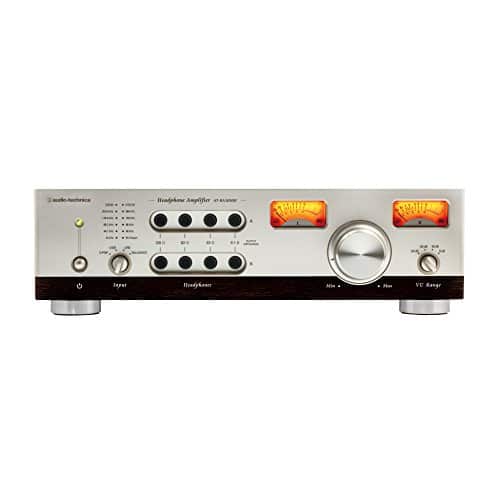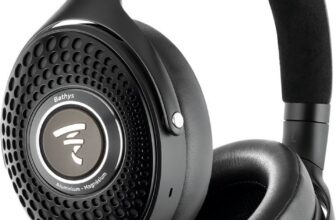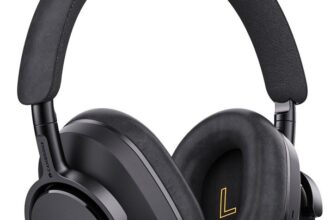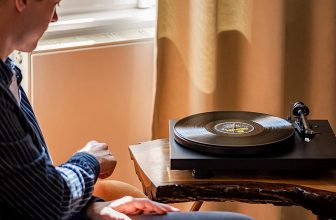Audio-Technica AT-HA5050H Review

What could be more logical than for a famous headphone manufacturer to offer an audiophile headphone amp? Still, the AT-HA5050H offers surprises on various fronts
Hybrid electronics are nothing new in high-end audio, but products which mix valves (tubes) and transistors remain rare enough that this new flagship headphone amp from Audio-Technica is the first hybrid design to have come my way.
And that isn’t all that makes the AT-HA5050H unusual. For a start, it’s large and it’s heavy – not quite large or heavy enough to be the equivalent of a full-size integrated amplifier, but not far short. Certainly it will fill a shelf in an equipment rack. Also, it has no fewer than eight ¼in jack output sockets on its fascia, grouped into two rows of four, and a pair of VU meters, one for each channel.
SELECTABLE IMPEDANCE
The output sockets offer 0.1, 33, 82 and 120ohm output impedances for one or two pairs of headphones, this arrangement being preferred to a switchable output impedance because, A-T says, it ‘allows for a superior noise performance’.
What’s the point of selectable output impedance? A-T offers two justifications, the more prosaic of which is that if two headphones of differing sensitivity are connected to outputs A and B, connecting the more sensitive of the two via higher output impedance will reduce its output level, bringing it closer to that of the lower sensitivity one. In respect of sound quality, A-T says that dynamic range, control, headroom and power output are all improved at low output impedance, the only advantage of higher output impedance being that it gives more bass.
A-T is being somewhat parochial here: its over-ear headphones – those that we’ve measured, anyway – have an impedance peak at low frequency, and this will indeed result in an effective bass boost if the amplifier’s source impedance is increased. But not all headphones have raised impedance at LF, notably planar magnetic types (eg, Audeze, Oppo) which have a virtually constant impedance across the entire audible spectrum. Changing source impedance with these headphones will make a negligible difference to their frequency responses.
The VU meters I regard as a pointless extravagance. What are you supposed to glean from them? I turned the VU range control up to 0dB so that their needles did little other than twitch occasionally.
It may seem odd that A-T has not offered a balanced output on the HA5050H, particularly given its price, but bear in mind that none of its own headphones provides for balanced connection. Does this mean that A-T sees no merit in balanced headphone operation or merely that it might encourage awkward questions were the HA5050H to provide a facility that its own headphones were unable to exploit? It would be interesting to know the answer.
As well as being a valve/transistor hybrid (selected E88CC twin triodes in the input stage feeding a solid-state class A output stage featuring Toshiba bipolar transistors), the HA5050H is also a headphone amp/DAC hybrid, offering digital input via S/PDIF (coax) or USB (Type B socket) alongside balanced and unbalanced analogue inputs on three-pin XLR sockets and phono sockets respectively.
There is no analogue output, so the HA5050H cannot double as a simple preamp. A switch alongside the analogue inputs offers 12dB attenuation and, unusually, the USB input has a small switch above it to select between ‘asynchronous’ and ‘adaptive’ modes of connection. The HA5050H’s instruction booklet gives no guidance on how to set this other than ‘Make selection based on environment of computer to be used’. What it should say is to use asynchronous – and if it doesn’t work, then fix the problem!
DIFFICULTIES WITH DSD
As usual, computers running a Mac OS can be connected via USB without further ado whereas machines running a Windows OS require a driver to be downloaded and installed. Compatible OS versions are X10.9 for Mac and 7/8/8.1 for Windows.
For PCM files, sampling rates of up to 192kHz are supported via the coaxial input and up to 384kHz via USB. Anyone interested in replaying DSD files via the USB interface would do well to read the ‘USB Compatibility List’ on page 25 of the instruction booklet.
If you are content to use the DoP interface standard, then DSD64 and DSD128 files are supported using either ASIO or WASAPI. Native DSD streaming is another matter: neither DSD64 nor DSD128 can be replayed using WASAPI and the ASIO option supports only DSD64. Worryingly, if you inadvertently try to play a DSD128 file via ASIO ‘a loud distorted sound will be emitted’. The best advice, then, is to use the DoP option unless you find native replay of DSD64 files convincingly superior – in which case be very careful not to play DSD128 files without first switching to DoP.
It’s interesting in this context to compare the AT-HA5050H with the much cheaper Teac UD-503. Not only does the latter offer upsampling and filtering options that the AT-HA5050H lacks, it additionally offers DSD256 compatibility and will accept DSD64, DSD128 and DSD256 delivered natively via USB. Plus it provides a choice of 50kHz or 150kHz corner frequencies for DSD output filtering. The UD-503 is unusually versatile in this department, it must be said; nevertheless it still leaves the AT-HA5050H looking a little short on DSD capability. And it also lacks the UD-503’s 10MHz clock input.
SEDUCTIVE SOUNDS
I began with the analogue input. A-T says of its choice to use a hybrid circuit that the valve preamp stage ‘adds warmth and depth to your music’, and that’s a fair description of the HA5050H’s core sound quality. But if this puts you in mind of a stereotypically soft, lazy valve sound, forget it: the HA5050H is bristling with subtle detail and dynamic shading.
I began by playing Jimmy Cobb’s ‘I Had The Craziest Dream’ from In the Key Of Blue [Chesky Records, HDtracks 96kHz/24-bit download], a piece of easy-going, immaculately recorded jazz that poses the twin challenges of centre-stage trumpet and, to the right, brushed percussion. The HA5050H breezed through it with the subtle drum and cymbal textures well resolved and the trumpet sound meticulously controlled, all within a believable and expansive stereo image.
Christy Baron’s stylish take on ‘Got To Get You Into My Life’ [also Chesky Records, 96kHz/24-bit HDtracks download], features well recorded percussion too but this time it’s more energetic and insistent. Again the HA5050H conveyed a naturally warm sound that was at the same time crisp and clean without ever seeming overcooked, and it proved particularly seductive with the female vocals.
Climbing down the quality ladder to 44.1kHz/16-bit material ripped from CD, Todd Rundgren’s ‘For Lack Of Honest Work’ [A Cappella, Rhino R2 75761] – a ultitracked, unaccompanied folk-like part song in which Rundgren harmonises with himself – was unpicked to make plain the use of artificial reverb but, more importantly, delivered the full self-loathing pathos of a working man who has descended into the gutter from what he’d thought was a union-protected job for life.
With both the A-T and Sony’s now discontinued MDR-MA600 ’phones I found myself using volume settings well down in the bottom half of the available range, so I tried the 12dB attenuation offered by the rear panel switch. This resulted in volume settings nearer mid-way, making fine loudness adjustment easier, but I didn’t care for the effect on sound quality that now seemed to have become a little ‘slugged’ by comparison.
LOWER THE BETTER
Neither did I much care for the results of plugging either headphone into the sockets providing a 33, 82 or 120ohm output impedance. As the source impedance ‘seen’ by the headphones increased, so the sound became greyed, softened and less vital. The low-impedance Sony was, unsurprisingly, more obviously affected than the ’A2000Z but the same trend was heard using both.
Via the 0.1ohm output the HA5050H is, without question, a top-notch headphone amplifier; via the other outputs it is progressively transformed into something less distinguished. As we found with the damping control on the Teac HA-501, there are occasional tracks on which the more emollient sound of a higher source impedance (reduced damping) might be preferable, but generally a high damping factor gives the best sound. A-T, if insistent on this feature, would have done better, I think, to offer a smaller range of output impedances.
Next I switched to a digital source and compared the S/PDIF input to the USB input with JRiver Media Center, equivalently configured, as the software player of choice in both cases. The sound via S/PDIF was excellent but I quickly noticed that the ladder of small LEDs on the HA5050H’s facia were indicating the wrong sampling rate. I was about to start writing down what was mistaken for what when I realised that the HA5050H was displaying the sampling rate of the previous item, not the current item. Weird – and, if it’s not peculiar to the review sample, something I hope A-T has now fixed. The same behaviour was not evident on the USB input.
Teac’s UD-503 proved the first and only instance where I preferred the USB option to S/PDIF, but with the HA5050H I found myself back in familiar territory, giving the nod to the S/PDIF interface. Two classical tracks featured in the comparison: Emma Kirkby singing ‘Full Fathom Five Thy Father Lies’, ripped from the BIS SACD Musique And Sweet Poetrie and converted to 88.2kHz/24-bit PCM; and the 96kHz/24-bit transfer of the third of the Dallas Symphony/Johanos Rachmaninov Symphonic Dances, ripped from Classic Records DAD 1004.
Contrasting as these pieces are – a moving ballad with lute accompaniment and a full orchestral showpiece – they told the same story. The sound via S/PDIF was that bit more expansive, both spatially and dynamically, than that via USB.
VERDICT
This is one of the finest ’phone amplifiers I’ve heard. I’m not enamoured of the selectable output impedance or the otiose VU meters – and the sampling rate display was wrong on S/PDIF – but when it comes to raw sound quality (from the 0.1ohm outputs) the AT-HA5050H is a very fine performer. Few audio products strike near-ideal balance between natural warmth and forensic resolution; the HA5050H does.
SPECIFICATIONS
Maximum output (re. 1% THD into 47kohm) 5.8VMax. power output (re. 1% THD into 25ohm) 1165mW Output Impedance (20Hz-20kHz) 0.89-4.13ohmA-wtd S/N ratio (re. 0dBV/ digital re. 0dBFs) 98.9dB / 105.9dB Frequency response (20Hz-20kHz/25ohm) –0.04dB to +0.01dB Distortion (20Hz-20kHz, re. 40mW) 0.22-0.024%Digital jitter (S/PDIF / USB) <10psec / <10psecPower consumption 31W Dimensions (WHD) / Weight 332x100x327mm / 11kg.





